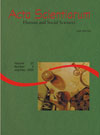<b>The endogenous development theory as industrial organization</b> - DOI: 10.4025/actascihumansoc.v27i2.197
Abstract
This paper presents the theory of endogenous development theory as a means of industrial organization, from a neo-Schumpeterian approach, on a new paradigm based on Information and Communication Technology. This new paradigm based on the flexible accumulation model, with decentralized production, and less dependent on the existence of economies of scale, makes possible opportunities for the development of small and medium enterprises. From this perspective, the new local/regional development strategies evidence various interrelated concepts such as industrial districts, clusters, local productive and innovative systems and arrangements and milieux innovateurs, that show the importance of micro, small, and medium enterprises for the development process of a region.These concepts include elements such as interaction, cooperation, joint actions and others, as determinants for the better performance of enterprises and, consequently, of regional economic development, or rather a new industrial organization.Downloads
Download data is not yet available.
Published
2007-11-13
How to Cite
Campos, A. C. de, Callefi, P., & Sousa, J. B. da L. de. (2007). <b>The endogenous development theory as industrial organization</b> - DOI: 10.4025/actascihumansoc.v27i2.197. Acta Scientiarum. Human and Social Sciences, 27(2), 163-170. https://doi.org/10.4025/actascihumansoc.v27i2.197
Issue
Section
Economy
DECLARATION OF ORIGINALITY AND COPYRIGHTS
I Declare that current article is original and has not been submitted for publication, in part or in whole, to any other national or international journal.
The copyrights belong exclusively to the authors. Published content is licensed under Creative Commons Attribution 4.0 (CC BY 4.0) guidelines, which allows sharing (copy and distribution of the material in any medium or format) and adaptation (remix, transform, and build upon the material) for any purpose, even commercially, under the terms of attribution.
Read this link for further information on how to use CC BY 4.0 properly.























